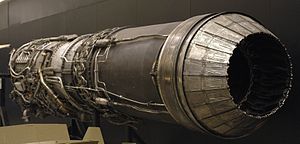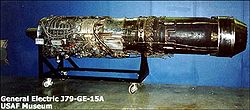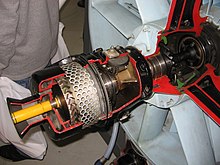General Electric J79
| J79 | |
|---|---|

| |
| J79 on display at the National Museum of the United States Air Force | |
| Type | Afterburning turbojet |
| National origin | United States |
| Manufacturer | General Electric Aircraft Engines |
| First run | 20 May 1955 (first flight) |
| Major applications | Convair B-58 Hustler IAI Kfir Lockheed F-104 Starfighter McDonnell Douglas F-4 Phantom II North American A-5 Vigilante |
| Number built | >17,000 [1] |
| Developed from | General Electric J73 |
| Variants | General Electric CJ805 |
| Developed into | General Electric CJ805-23 |
The General Electric J79 is an axial-flow turbojet engine built for use in a variety of fighter and bomber aircraft and a supersonic cruise missile. The J79 was produced by General Electric Aircraft Engines in the United States, and under license by several other companies worldwide. Among its major uses was the F-104 Starfighter, B-58 Hustler, F-4 Phantom II, A-5 Vigilante and IAI Kfir.
A commercial version, designated the CJ805, powered the Convair 880, while an aft-turbofan derivative, the CJ805-23, powered the Convair 990 airliners and a single Sud Aviation Caravelle intended to demonstrate to the U.S. market the benefits of a bypass engine over the existing Avon turbojet.
In 1959 the gas generator of the J79 was developed as a stationary 10MW-class (13,000 bhp) free-turbine turboshaft engine for naval power, power generation, and industrial use, called the LM1500.[2][3] Its first application was in the research hydrofoil USS Plainview.
Development[]
By the late 1940s, jet engine design had progressed to the point where further progress was limited by the performance of the compressor. It is difficult to produce a design that runs efficiently under a wide variety of conditions, and those conditions change dramatically in practical operation as the aircraft starts at rest on the ground and later flies near Mach speed at high altitudes. To avoid compressor stalls the overall pressure ratio had to be limited. Early wartime engines like the Junkers Jumo 004 and Rolls-Royce Welland had ratios just over 3:1.
Axial compressors work by accelerating air over a series of airfoils, one set connected to a rotating shaft, the "rotor", and a second set connected to the outer frame of the engine, the "stators". It is the physical relationship between these two components and their relative speed that tunes the compressor for certain conditions. Early models of the Rolls-Royce Avon, then still known as the AJ65, tended to break off the blades in the first stages of its compressor when running at low speed. In 1949, RR built an experimental version of this engine where several rows of stator blades at the forward low-pressure section could be rotated to lower the compression while running at low speed. This solution proved to have several difficult problems, including the leakage of high-pressure air into the bearings on the inside of the engine. They ultimately abandoned the concept and replaced it with a simpler system with a single variable inlet and a system to "bleed" air out of the early stages of the compressor during startup.[4] This allowed the engine to enter service with a compression ratio of 6.2:1, a great advance that was further improved in later versions to as high as 8.8.[5] This proved extremely influential, and many engines of the era used these concepts, including the General Electric J73.
In 1951, GE decided to try their hand at the variable stator design. A team led by Gerhard Neumann produced a prototype with the inlet and first five stages of the 14-stage stator being variable. Testing of the design, known as X24A,[6] was completed in May 1952. Soon after, the Air Force put out a contract for a new engine with approximately 14,000 pounds thrust to power a new supersonic bomber design. The Aircraft Gas Turbine Division lead, C.W. 'Jim' LaPierre, formed two teams to consider an engine that could run for extended times at Mach 2.0 while still offering good fuel economy in a cruise at Mach 0.9. Gerhard Neumann was put in charge of a team using the variable stator concept of the X24, while Chapman Walker led a parallel effort using a two-spool design. A comparison of the resulting designs showed the variable stator was both lighter, simpler and had a smaller diameter.[4][7]
GE won the Air Force contract on 3 December 1953, and was awarded contract MX2118 intended to power the Convair B-58 Hustler. The two other engines offered by GE, an advanced version of the existing J73 and a much larger design known as the J77, were both canceled. The contract started with a prototype of the new design, GOL-1590. It ran for the first time on 16 December 1953, but quickly accelerated out of control and was damaged. The engine was repaired and ran again three weeks later, and quickly demonstrated excellent performance that led the team to question the accuracy of their test equipment. The first prototype of the production version, XJ-79, ran on 8 June 1954.[4]
The first flight of the engine was on 20 May 1955 where the engine was placed in the bomb bay of a J47-powered B-45C (48-009). The J79 was lowered from the bomb bay and the four J47s were shut down leaving the B-45 flying on the single J79.[8] The first flight after the 50-hour qualification test was on 8 December 1955, powering the second pre-production Douglas F4D Skyray, with the J79 in place of its original Westinghouse J40 engine as part of the General Electric development and qualification program. The YF-104 was the next airplane to fly with the J79 followed by a re-engined Grumman F11F Tiger in a Navy-sponsored program to gain experience with the engine before the first flight of the F4H (F-4).
The J79 was used on the F-104 Starfighter, B-58 Hustler, F-4 Phantom II, A-5 Vigilante, IAI Kfir and SSM-N-9 Regulus II supersonic cruise missile. It was produced for more than 30 years. Over 17,000 J79s were built in the US, and under license in Belgium, Canada, Germany, Israel, Italy, and Japan. A downgraded version of the F-16 Fighting Falcon with a J79 was proposed as a low-cost fighter for export, and though a prototype aircraft was flown, it found no customers.
The J79 was replaced by the late 1960s in new fighter designs by afterburning turbofans such as the Pratt & Whitney TF30 used in the F-111 and F-14, and newer generation turbofans with the Pratt & Whitney F100 used in the F-15 Eagle which give better cruise fuel efficiency by-passing air around the core of the engine.
For their part in designing the J79, Gerhard Neumann and Neil Burgess of General Electric Aircraft Engines were jointly awarded the Collier Trophy in 1958, also sharing the honor with Clarence Johnson (Lockheed F-104) and the US Air Force (Flight Records).[9]
Design[]

The compressor blades and vanes are made of 403 stainless steel, except for the -3B and -7A variants, which have A286 vanes at stages 7 through 17. The compressor rotor is made of Lapelloy, B5F5 and titanium.[10] The J79 makes a particular howling sound at certain throttle settings. This strange feature led to the NASA operated F-104B Starfighter, N819NA, being named Howling Howland.[11] Early engines also produced noticeable quantities of smoke, especially at mid-throttle/cruise settings, a disadvantage in combat aircraft making them vulnerable to visual detection. Later models were redesigned to be "smokeless".
The turboshaft counterpart to the J79 is the General Electric LM1500, used for land and marine applications. Many J79 derived engines have found uses as gas turbine power generators in remote locations, in applications such as powering pipelines.
The J79 has two commercial derivatives: CJ805-3 (a non-afterburning engine, fitted with thrust reverser and sound suppressor), and the CJ805-23 (with a free-wheeling aft fan and thrust reverser) fitted to the Convair CV-880 and the Convair CV-990 respectively.
With air-start systems gas turbine engine compressor spools are rotated by the action of a large volume of compressed air acting directly on the compressor blades or driving the engine through a small, geared turbine motor.
Variants[]

- XJ79-GE-1
- Prototype. First ground static test run on 8 June 1954 produced 14,350 lbf (63.83 kN) with afterburner.[12]
- YJ79-GE-1
- Flight test engines were designated YJ79-GE-1.
- J79-GE-2
- Powered the McDonnell F-4H-1 Phantom (F-4A), 16,100 lbf (71.62 kN) of afterburner thrust.
- J79-GE-2A
- essentially similar to the -2
- J79-GE-3
- Used in the YF-104A, F-104A and the Grumman F11F-1F Super Tiger
- J79-GE-3A
- YF-104A, F-104A and F-104B.
- J79-GE-3B
- F-104A and F-104B.
- J79-GE-5A
- Convair B-58 Hustler 15,600 lbf (69.39 kN) with afterburner.
- J79-GE-5B
- Convair B-58 Hustler 15,600 lbf (69.39 kN) with afterburner.
- J79-GE-5C

- J79-GE-7
- F-104C, F-104D and F-104F.
- J79-GE-7A
- F-104C, F-104D and F-104F.
- J79-OEL-7
- Licensed production GE-7 manufactured by Orenda Engines to power the Canadair CF-104.
- J79-GE-8
- North American A-5 Vigilante and F4H-1 (F-4B) with 16,950 lbf (75.4 kN) of afterburner thrust
- J79-GE-8A
- Sub-variant of the -8
- J79-GE-8B
- Sub-variant of the -8
- J79-GE-10
- F-4J, 17,900 lbf (79.379 kN) of afterburner thrust.
- J79-GE-11
- J79-GE-11A
- F-104G and TF-104G. 15,600 lbf (69 kN) with afterburner. Many -11 engines were licensed manufactured in Europe as part of the large F-104 consortium production programme, Alfa Romeo, Fiat and Fabrique Nationale being the main suppliers for the project.
- J79-IHI-11A
- Licensed production GE-11A, built in Japan by Ishikawajima-Harima Heavy Industries Co., Ltd to power their similarly licensed built F-104J and F-104DJ Starfighters.
- J79-MTU-J1K
- Licensed built and improved version of the GE-11A manufactured by MTU Aero Engines in Germany.
- J79-GE-15
- F-4C, RF-4C, F-4D; with 17,000 lbf (75.6kN) of afterburner thrust.
- J79-GE-17
- F-4E, RF-4E, F-4EJ, F-4F, F-4G; with 17,900 lbf (80 kN) of afterburner thrust.
- J79-GE-19
- Aeritalia F-104S; also retrofitted to F-104A's of the 319th FIS.
- J79-GE-J1E
- License-built in Israel by Beit Shemesh Engines Ltd. (BSEL)[citation needed] with 18,750 lbf (83.40 kN) afterburning thrust for the IAI Kfir.
- J79-GE-119
- F-16/79
Applications[]

- Aircraft
- Convair B-58 Hustler
- General Dynamics F-16/79
- Grumman F11F-1F Super Tiger
- IAI Kfir
- Lockheed F-104 Starfighter
- McDonnell Douglas F-4 Phantom II
- North American A-5 Vigilante
- Northrop X-21
- SSM-N-9/RGM-15 Regulus II
- Land speed record cars
- Art Arfons' "Green Monster"
- Craig Breedlove's "Spirit of America - Sonic 1"
- North American Eagle Project
Specifications (J79-GE-17)[]


General characteristics
- Type: Afterburning turbojet engine
- Length: 208.69 in (5.301 m)
- Diameter: 39.06 in (0.992 m)
- Dry weight: 3,835 lb (1,740 kg)
Components
- Compressor: single-spool 17-stage axial compressor, with one row of variable inlet guide vanes (VIGV's) followed by 6 rows of variable stator vanes
- Combustors: cannular
- Turbine: 3-stage
- Fuel type: JP-4, JP-5
Performance
- Maximum thrust: 11,870 lbf (52.8 kN) dry; 17,900 lbf (80 kN) with afterburner
- Overall pressure ratio: 13.5:1
- Air mass flow: 170 lb/s (77 kg/s)
- Turbine inlet temperature: 1,710 °F (930 °C; 1,210 K)
- Specific fuel consumption: 1.965 lb/(lbf⋅h) or 55.7 g/(kN⋅s) with afterburner, 0.84 lb/(lbf⋅h) or 24 g/(kN⋅s) at military thrust
- Thrust-to-weight ratio: 4.6
See also[]
- North American Eagle
- United States military aero engine designations
Related development
Comparable engines
Related lists
- List of aircraft engines
References[]
Notes[]
- ^ General Electric - Aviation History Retrieved: 7 April 2008
- ^ Stoeckly, E. E. (1 April 1966). "Development of the General Electric LM 1500 Gas Turbine as a Marine Power Plant". . 88 (2): 144–152. doi:10.1115/1.3678497.
- ^ "Taking it back to 1959 when the J79 turbojet engine was reconfigured as the LM1500". General Electric. 1959.
- ^ Jump up to: a b c Brimer, Matt (26 August 2017). Designing Simplicity to Achieve Technological Improvement: The General Electric J79 Turbojet Engine; Innovations, Achievements and Effects (Technical report). University of Missouri, St. Louis.
- ^ Rolls-Royce Aero Engines" Bill Gunston, Patrick Stephens Ltd. 1989, ISBN 1-85260-037-3, p.133
- ^ "seven decades of progress" General Electric, Aero Publishers Inc. 1979, ISBN 0-8168-8355-6, p.89
- ^ "Starting Something Big" Robert V. Garvin, AIAA Inc. 1998, ISBN 1-56347289-9, p.13
- ^ Pace 1992 p. 67.
- ^ Collier Trophy winners, 1950–1959 Archived 2008-12-11 at the Wayback Machine, National Aeronautic Association. Retrieved: 7 April 2008
- ^ Taylor, John (1975). Jane's All The World's Aircraft 1974-1975. p. 747.
- ^ Bashow 1986, p. 16.
- ^ Pace 1992, p. 69.
- ^ Taylor, John (1975). Jane's All The World's Aircraft 1974-1975. pp. 747–748.
- ^ AgentJayZ (2010). "J79 - Turbine Engines: A Closer Look". Retrieved August 25, 2020.
Bibliography[]
- Neumann, Gerhard (June 1984). Herman the German. William Morrow & Co. p. 269. ISBN 978-0-688-01682-1.
The former enemy alien and Air Corps G.I. whose inventive skills and maverick management techniques made jet engine history
- Pace, Steve. Lockheed F-104 Starfighter. Osceola, Wisconsin: Motorbooks International, 1992. ISBN 0-87938-608-8.
- Bashow, David L. Starfighter: A Loving Retrospective of the CF-104 Era in Canadian Fighter Aviation, 1961–1986. Stoney Creek, Ontario: Fortress Publications Inc., 1990. ISBN 0-919195-12-1.
- Gunston, Bill. Fighters of the Fifties. Cambridge, England. Patrick Stephens Limited, 1981. ISBN 0-85059-463-4.
- Williams, Nick and Steve Ginter "Douglas F4D Skyray". Simi Valley, California: Ginter, 1986. ISBN 0-942612-13-2.
External links[]
| Wikimedia Commons has media related to General Electric J79. |
- General Electric aircraft engines
- 1950s turbojet engines